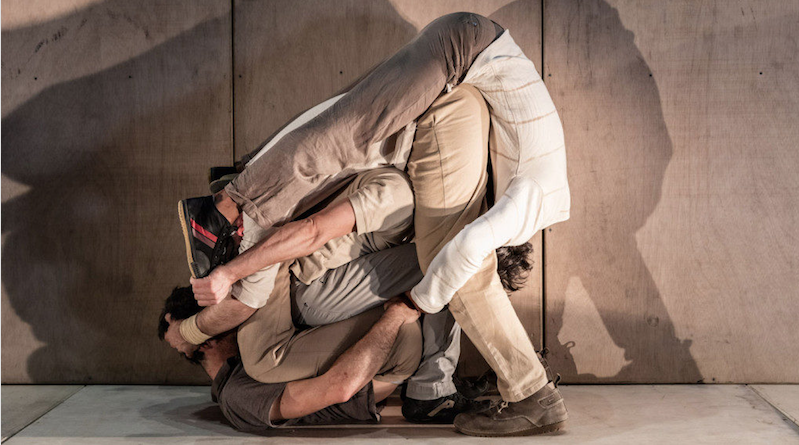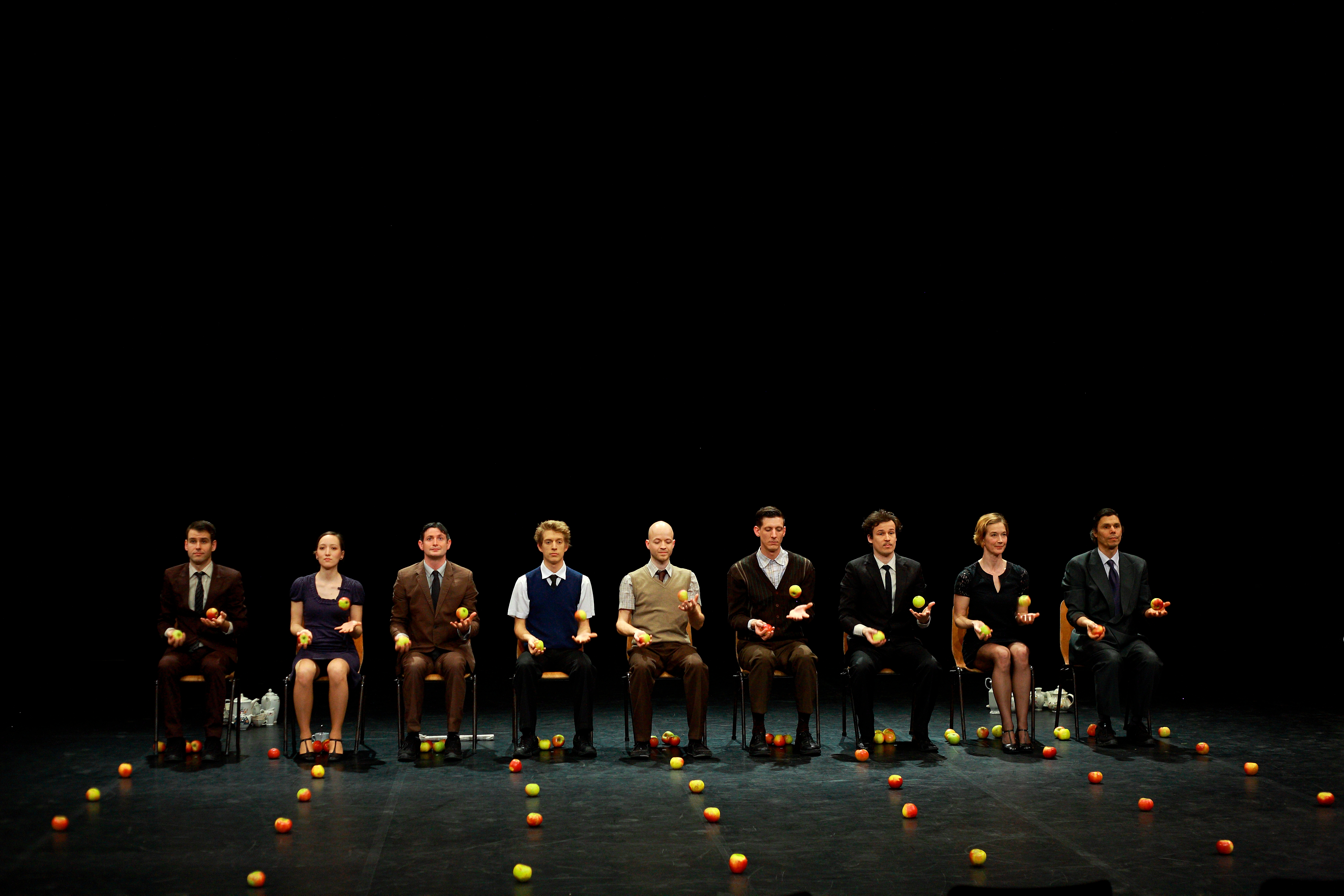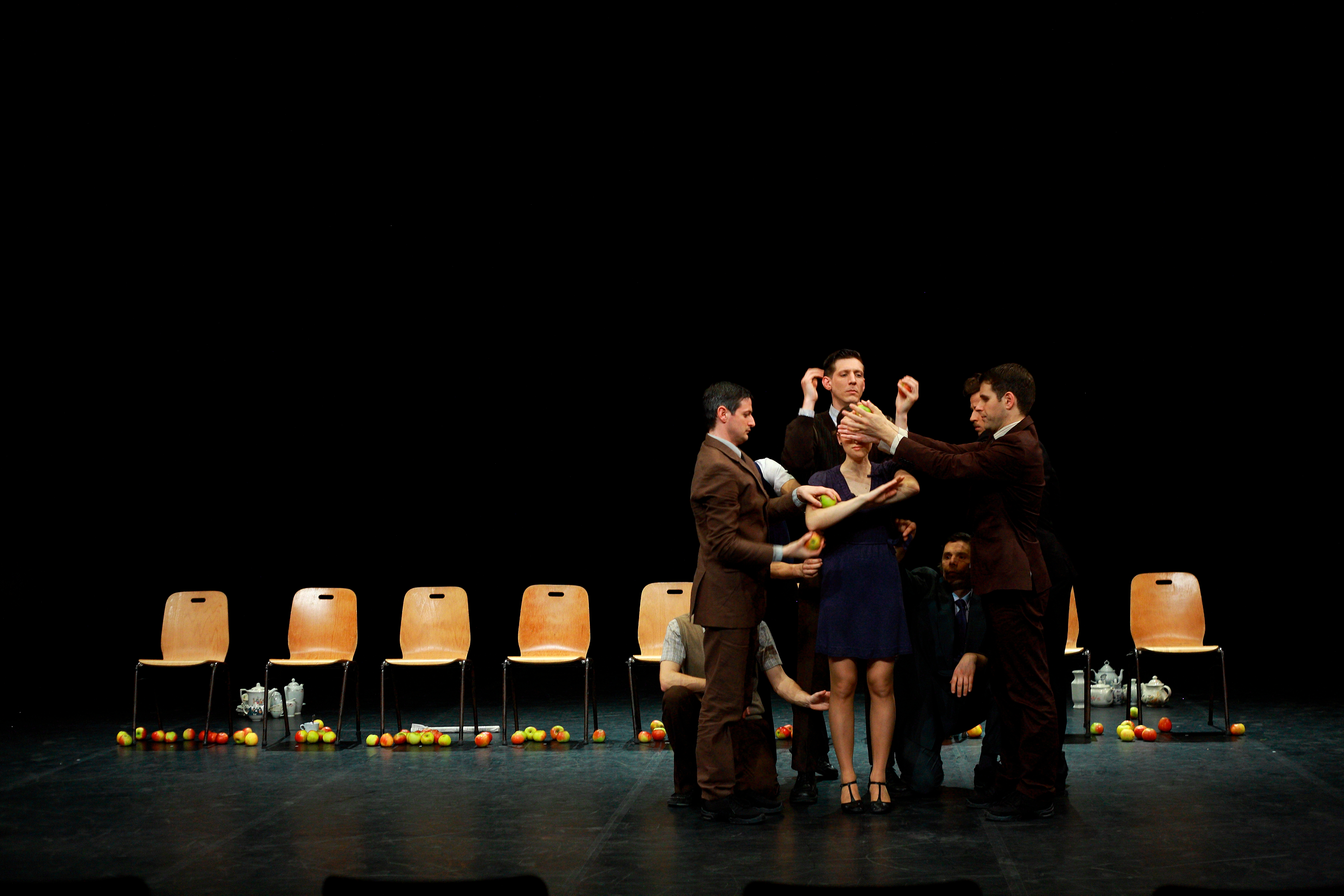Men In the Ring — the Rise of the Boy Bands of Circus
The Circus world is experiencing more and more activities and events that focus on gender and its influence in circus productions. Here are a few examples: articles (such as this one by Susie Williams), open talks (such as the one held in Barcelone last April) or festivals (such as Festival CAU, in Grenade, Spain). Just last week in Montreal, there were two events (Cirque Off& Circus, Culture & Diversity) sandwiching the Montréal Complètement Cirque festival that covered the issue of gender as encompassed in a larger discussion about diversity in circus. All of these examples recognize the need for more diversity on and off the stage, especially in terms of gender. These occasions offer us an excellent opportunity to exchange ideas about circus from this point of view. In this text, I would like to examine the changing role masculinity plays in some contemporary circus companies.
Of course, masculinity is also part of gender studies, but since we have culturally learned that “masculine is normal”, we sometimes take for granted that men’s representation have nothing to tell us in terms of gender, hence nothing to investigate. Yet every piece of art is related to cultural codes that we can decipher, and the ones made by men are no exception. Circus is part of the world we live in, although as with every form of art, one of its prerogatives is to reinvent and enrich reality. In classic circus, gender has a dominant role, linked to the family and business structure. It is generally understood that many circus disciplines have traditionally been related to gender: we have a common past in which clown, juggling, strength have been for male artists, while antipodism, aerial solos, and contortionism have been mainly a matter for female artists. Of course, there are always historic examples of transgressions, but they are often presented as that, as the exceptions that confirm the norm.
But, what about contemporary circus? Like many contemporary branches of art, it is proud to introduce itself as a free, thrill seeking enterprise. Let’s examine some cases where some young circus companies address masculinity and perhaps attempt to break the gender roles traditionally prescribed to them.
The Players
In her excellent article about the need for more diversity on stage, Susie Williams reflected on the overwhelming presence at the circus festivals of shows composed mainly by men with specific characteristics: “young, fit, exuberant guys and maybe one flexible girl who performs a sensual/sentimental/romantic solo act”. Williams states that she doesn’t mean to disregard these artistic proposals, nor do I. But I would like to propose that to take a closer look at them will help us to understand how these cultural codes work and are conveyed via masculinity. Let’s take a look at some companies who could be defined by this.
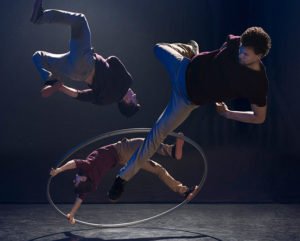
Williams mentions one example of a high quality show made by young, fit, exuberant guys: Bromance by the English company Barely Methodical Troupe. The title itself is an explicit reference to masculinity. Bromance is a term that fuses brother and romance: according to Wikipedia, “a close, emotionally intense, non-sexual bond between men”. In Bromance, we can find references to fellowship, with intensity and a sense of humor. They take their clothes off to end up an acrobatic act in underwear. They pinch their nipples, sniff their armpits, they dance a boy band parody. So the game is explicitly about ‘being a boy in a boy’s body, surrounded by boys’. It’s interesting to notice that there are other artistically excellent companies who also play this game, all formed by males: Race Horse Company from Finland, La Meute from France, or Machine de Cirque from Canada. Race Horse Company’s Super Sunday (2014), is presented by a subtitle that says “Performed by men, supervised by women”. The artists appear on stage as cowboys, and then enter into a playful state where they act like enthusiastic children. The second part of the show features another parody of a ‘spectacular’ aerial act in which acrobat Odilon Pindat wears an impossible trikini, with the final act as a more solemn death wheel act by Pindat and Petri Tuominen. In La Meute (2013), the acrobats wear nothing but towels, but the premise is the same: to be together, to play together, to show the others how far you can go. They play with the risk of losing the towel and showing excessive nakedness, a threat to classic masculinity, in which the man controls his exposure.
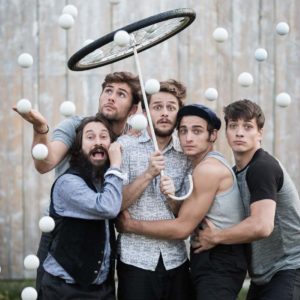
At Machine de cirque (2015), the artists base the dramaturgy on a dystopic future :“15 years after the Apocalypse, five men still manage to survive. Their ultimate quest is to find other survivors. Their way to salvation is a most astounding machine. In this spare-parts world, they creatively compete to retain a sliver of humanity. Armed with their talent for acrobatics and ingenuity, you’ll see how they get around in this world without women or computers.” Please note the “without women” scenario. This is the text you can read on their website or press kit; but once on stage, it’s hard to find any effective reference to this apocalypse. And one wonders if it was just a back story made up to justify the lack of presence of any women. Which begs the question–why would no women exist in an apocalypse? The show also includes a towel scene, and a unicycle act by Raphael Dubé in which the other artists parody a girlie chorus, panicking and applauding in a satirical manner.
If they find the feminine to be remote and strange, then they have the right to portray it like that. Just as it is our due and right as the audience to analyze it and come to a conclusion if we detect more than one case happening– which points to a trend.
Other companies of young men explicitly show an interest in transgressing normative gender. Some of them, such as Subliminati Corporation in #numberfiletone(France, 2012), and Svalbard in All genius all idiot (Sweden, 2016) explore the transgression of roles and include some props and images traditionally linked to the feminine: stilettos, wigs, make-up… but many times they end up by limiting their image of feminine or “not straight” to negative connotations: parodic, excessive, victim, passive, tortured. In #numberfiletone juggler Jordi Querol wears a dress and a wig, carries flowers for the performers, and as one of his last womanly images he shows us his mouth in a frozen, painful smile; then lifts his dress and shows us his pelvis with his hidden penis held between his legs –like in the famous Silence of the lambs scene. In this scenario, the normative masculine remains strong, because the other possibilities have been treated in an exoticizing or tragical way, as somehow marginal, weak or stigmatized.
Questioning Cultural Codes
Many of these parodies work as a mechanism to balance the strong presence of the classic masculine persona throughout the whole show: acting as a interstitial comedic chapter featuring acrobats in trikinis, wigs or pantomiming ‘girlie’ behaviors. But that is eventually dropped and the last part of the show is finally “serious”: a virtuoso final act in which the male artist is stripped of his artifice and able to technically give their best. The balance works very effectively –all of these shows have been very successful- and one under-examined positive outcome might be that these artists need to depart from an excessively masculine perspective during their performance in order to come to a more authentic expression in the end. Still, it would have been helpful for their creation processes to have invited an ‘ex
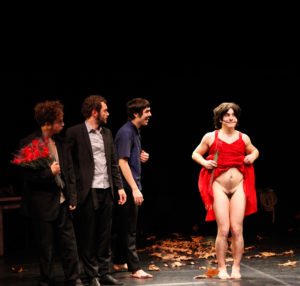
ternal eye’ that specialized in gender– not to impose political correctness– but to be more aware of what one is expressing to the audience. I find it very revealing that representation of these artist’s experience coincide in so many ways. If they find the feminine to be remote and strange, then they have the right to portray it like that. Just as it is our due and right as the audience to analyze it and come to a conclusion if we detect more than one case happening– which points to a trend.
I would like to focus on one company mainly formed by males, but whose show has widened the perspective inside this boy band new wave trend. Compañía de Circo “eia” is a Barcelona based company, formed by Catalan, Spanish and Italian artists. Their last show is intarsi, premiered in 2016, still touring around Europe. The dramaturgy is based, as in so many new circus companies, on the relationships among the acrobats: how to play, how to challenge, how to go to the next level– but in a relaxed, post classic circus manner.
intarsi offers some remarkable moments about new possibilities for vulnerability over bravado among men in the circus ring. For example: in one scene, acrobat Fabrizio Giannini has his clothes taken off by his colleagues, and he stays alone, just dressed in boxers. At first, it seems that this could be just another scene boyish game. He takes a look at the audience, looks at himself and then tries to flex his muscles. But a few seconds later, the strength goes down to his belly–and that makes us laugh–so he ends up dancing a kind of a sui generis and intense belly dance. He doesn’t fit in the image of the strong man, so he takes us to an unexpected place. When Compañía de Circo”eia” came to Madrid to perform intarsi at Teatro Circo Price, I organized a chat with the company and some other male circus artists. I asked them whether they had been aware about this gender issue from the beginning of the creation process. Fabrizio told us that they got there from an intuitive approach. They just started to create from their own personalities, and when they felt the interaction was getting “testosteronic” they would rethink it, because they didn’t want that result. When I asked him about the starting point of the belly dance scene, he said: “What does a man do when he reveals his body to others? He tries to seem strong and powerful. My character tries, but can’t”.

At intarsi, there are plenty of moments in which the performers touch, and the reactions and energies are quite different. They hug, they dance, some of them feel uncomfortable, others want more, the show ends with a very poetic image of all of them building a kind of a human, organic square in which the bodies fit together delicately. The opposite happens in the Machine de Cirque towels scene. Whenever they touch incidentally, they scream, they panic, performing the traditional cultural fear of the straight man towards being touched (especially on some parts of his body) by other men.
There is another intarsi scene in which three acrobats (Giannini, Eduardo Lucas and Armando Rabanera Muro) initiate a parodic folk dance. Like many folk dances, they start very straight and rigid. But one of them suddenly relaxes, breaks this verticality, the others follow him and they all end up dancing more freely. This reminds me of a reflection the Spanish juggler Carlos Romero once shared with me. He told me that the art of juggling had a very strong tradition linked to the male gender, very vertical, restrained and manly. But referents such as Victor Kee reinvented this, doing more ground based work, dancing, exploring the space with the body. Romero has performed with the British company Gandini Juggling, whose show Smashed presents the paroxysm of this image of the virile juggler: seven men in suit, all very polite and smiling, while two ladies also behave in a very refined way. But little by little they start developing disturbing– and funny–images of domination and humiliation, revealing what lies underneath the apparent correctness.
When we all have been told that “masculine is normal”, analyzing the masculine becomes a difficult task. Some of the attendants to the chat with Compañía de Circo “eia” confessed that the it was the first time they had thought about some issues. Others were extremely honest about their feelings towards the gender issue –“I guess I get a benefit from my privileges”, “I’m tired about the gender issue. I would like to make it disappear”- often analyzing their own creations as circus artists from their gendered point of view. For example, we had the chance to discuss with Daniel Sánchez, director of ProyectoSánchez & Combo Surimi company, about their last creation, Ippon; and with Jorge Silvestre, artistic director of Nueveuno company, about their show Sinergia 3.0. In Ippon, Daniel Sánchez commented that he had searched for a neutral gender. The show is based on a strong aesthetic of a sacred, Eastern influenced world. The performers manipulate long sticks, among dancing, juggling and puppet theatre. They wear costumes that are close to the tunic shape. Still, although there are are two female jugglers, the masculine presence is much bigger: four men jugglers, plus two male musicians. In Sinergia 3.0 by Nueveuno company, the four creators/performers started working on the “Vitruvio Man” by Leonardo Da Vinci. So even though the Nueveuno company didn’t intend to focus specifically on masculinity, they chose an imaginary framework that is strongly marked by masculine gender. As Professor Émilie Salamero said at the past open talk in Barcelone: “contemporary circus creation is based on a logic of similarities among creators, so habits work strongly when it comes to start projects”.

Circus, as every form of art, can give an opportunity for creators to redefine the representation of cultural codes, and of course of genders; to explore them, to reinvent them, to go further. Sharing knowledge –talking, reading, opening the creation processes- it is the only way to start the change. As someone said at the intarsi open talk, “Changes don’t come in a magical way. The only way of changing gender injustices is to be open to the analysis, to listen and to be self-critical”.
Feature photo courtesy of @BenHopper. All other images are courtesy of the companies.
...
Do you have a story to share? Submit your news story, article or press release.

